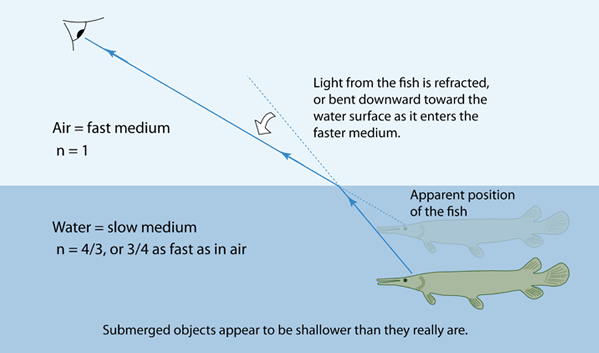The Gar Story
Objects submerged in water will appear to the eye to be shallower than they are because of the refraction at the water surface. Light entering or exiting a water surface is bent by refraction. The index of refracton for water is 4/3, implying that light travels 3/4 as fast in water as it does in vacuum.
This may sound very technical, but I learned about refraction in a very non-technical way as a small boy growing up on a farm in Arkansas. We had a small lake on our farm, and one of my fantasies was to stock that lake with game fish. We could hardly catch anything from the lake. So when I was about 12 and my younger brother about 10, we had the idea of taking buckets of small bass over to stock the lake. After a couple of buckets of small bass or crappie, we waited for what we thought was a reasonable period, about two weeks, and went over to see if we could catch any of those bass. We were sorely disappointed. We never saw any of those bass again.
On our trips to the lake, we noticed that it was the habit of some alligator gar fish to just hang in the water close to the surface in the middle of the day. We could sometimes see a half-dozen of these long fish clearly near the surface of the water. In our minds, it was tempting to blame the gar fish for our lack of success in stocking the lake. "I'll bet those gars just ate all of our little fish!" Their long snouts and sharp teeth made this scenario more attractive. So what would you do?

Having decided that the gar were the villains in this story, we banged away at them with everything in our arsenal, which in rural Arkansas is considerable. Starting with our .22 calibre squirrel-hunting rifles, we took aim at the gars. But we couldn't hit them. Another great disappointment. We thought of ourselves as good marksmen since we could shoot squirrels out of trees at a much greater distance. We escalated all the way up to our 30-30 hunting rifle, and could make a bigger noise and splash, but still didn't hit the gar.
After the waste of much ammunition, we started thinking "Maybe they aren't where they appear to be." By trial and error, we found that if we aimed a certain distance below them, we sometimes hit them. No, that's not true, we never put a hole in a gar fish! But we did find a reliable aiming point a certain distance below them, and if we aimed there we could stun the rascals and they would float up to the surface. Then we could row out and beat them with a stick! So we did away with a number of gar fish, but never caught one of the bass we had thrown in. It planted an indelible picture in my mind that things in the water are deeper than they appear to be. It was several years before I heard the word "refraction" to explain it.

For years I used the gar story in class along with the model of marching troops to explain the concept of refraction. The story is included here in honor of a student whom I encountered some ten years after he took an introductory physics course from me. He told me "The only thing I remember about that course was the gar story!"
| Refraction and the eye | Refraction of sound |
Lens concepts
| HyperPhysics***** Light and Vision | R Nave |